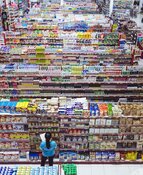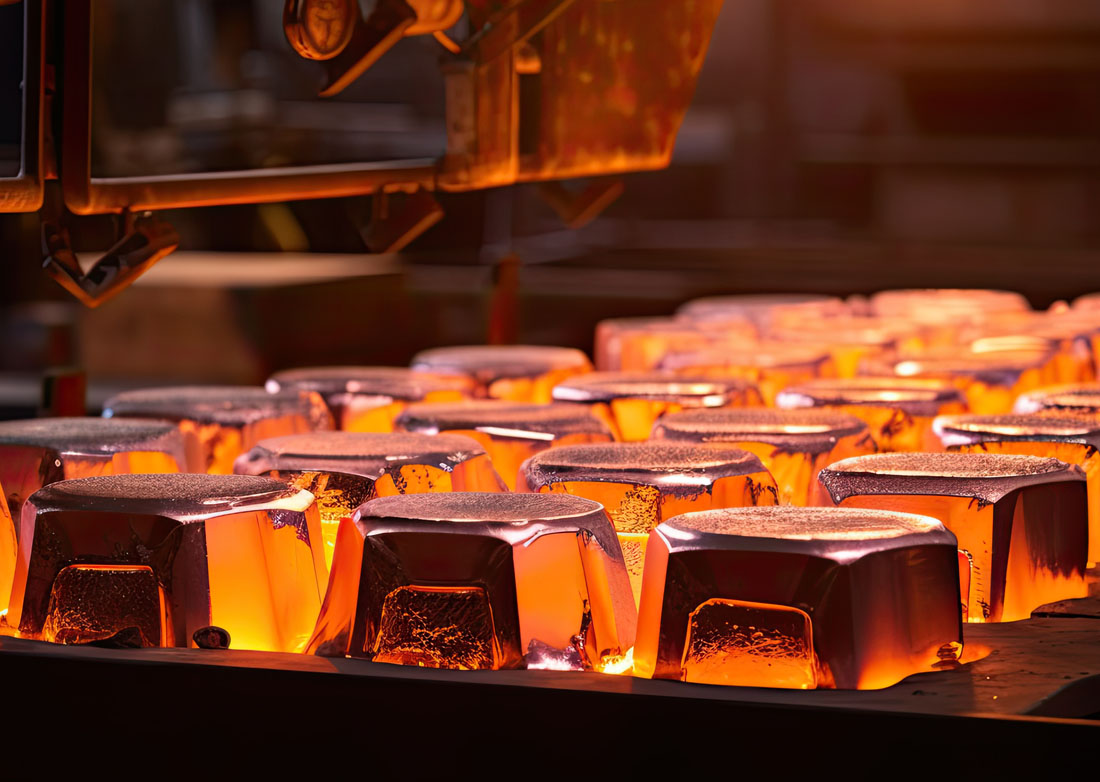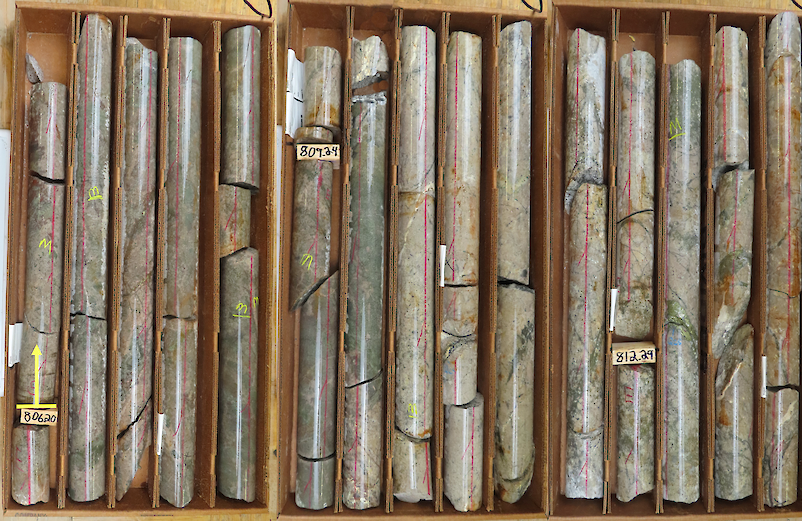The Metals & Mining industry encompasses the extraction (mining) as well as primary and secondary processing of metals and minerals. These include aluminum and gold, other precious metals, coal and steel. The industry is oligarchic in structure, with a few producers accounting for a lion's share of the output.
Iron and steel commands the largest segment of the global metals market. They comprise more than half the metals industry in terms of volume, followed by aluminum. The iron and steel industry includes metal ore exploration and mining services, as well as iron and steel foundries for smelting, rolling, forging, spinning, recycling, stamping, polishing and plating of iron and steel products. These include pipe and tube, wire and spring, rolls and bars.
The precious metal and minerals industry consists of companies engaged in the extraction and primary processing of gold, silver, platinum, diamond, semi-precious stones, uranium and other rare minerals and ores, along with the cultivation of pearls.
The global metal industry is highly cyclical and competitive. Historically it has suffered from overcapacity (excess of supply over demand). Metal producers are subject to cyclical fluctuations in prices, general economic conditions and end-user markets. The recent focus on the weakening outlook for global economic growth has emerged as a major headwind for the global metal industry. These near-term challenges aside, the group's long-term dynamics appear attractive.
A Detailed Look into Metals: Performance and Outlook
Steel
As the major stakeholder (about 60%) of the metals market, the steel industry was severely bruised by the global economic downturn. Recovery, however, has been swift and forceful. According to the World Steel Association, world crude steel production reached a record level of 1,527 million tons (Mt) in 2011, outperforming the 2010 record of 1,414 Mt, a 6.8% jump. This trend has largely remained in place this year, though the emerging growth worries will likely force some producers to take production off-line.
China remains the largest steel-producing country, accounting for roughly half of all global production at 46%, though its first quarter 2012 volumes were barely up from the year-earlier level. Japan, the second largest producer, posted a 4.1% decline. The U.S. is in the third position, though its first quarter production was 9.2% higher year over year. North American crude steel production was up 7.7% in the first quarter, Asia was flat, while Europe dipped 3.8%. In April 2012, world crude steel production was down 3% from March, but up 1% from the April 2011 levels.
As we look into the first quarter results of the steel companies in our coverage—ArcelorMittal, United States Steel Corp., Nucor Corporation and AK Steel Holding Corporation—we find revenues benefitted from higher average steel prices. On the volume front, ArcelorMittal and U.S. Steel saw a rise, while Nucor and AK Steel suffered declines. Revenues increased at all the companies except AK Steel. However, we note margin compression across the board.
The automotive and construction markets have historically been the largest consumers of steel. The automotive sector has shown significant promise. In February 2012, total motor vehicle sales reached their highest level since February 2008 at 15.1 million SAAR (Seasonally Adjusted Annual Rate). For the first five months of 2012, sales have averaged 14.4 million SAAR. Many auto manufacturers made their best Memorial Day sales in over five years. Motor vehicle sales were at 13.8 million in May, declining from 14.4 million in April. Even though sales slid to the lowest level so far in 2012, it is still better than consensus expectations from the beginning of the year. On a year-over-year basis, sales increased 26% in May.
The construction sector has been a drag on steel companies' earnings. According to the American Institute of Architects, the architecture billings index, an economic indicator that provides an approximately nine- to twelve-month glimpse into the future of non-residential construction spending activity, was 48.4 in April 2012. This followed a 50.4 reading in March, and of significance since any score above 50 indicates an increase in billings. After remaining at a level over 50 for five consecutive months, the index has slipped into negative territory. Given the continued uncertainty in the market, we do not expect any immediate recovery in this sector.
The residential construction market has improved in recent months, but the pace of improvement has been very slow and halting. This means that this end market is unlikely to emerge as a key growth driver for steel producers any time soon.
The World Steel Association projects global steel usage to rise 3.6% in 2012, a sharp deceleration from 2011's 5.6% growth. This reflects continuing slowdown of Chinese steel demand and Eurozone debt crisis uncertainties. Questions about the U.S. growth outlook make another cloud on the horizon.
China's steel use in 2012 is estimated to grow 4% to 648.8 million tons, following 6.2% growth in 2011. The slackening is due to the economy entering a less steel-intensive growth phase as a result of the government's efforts to rebalance the economy and restrain the real estate bubble. After a weak performance in 2011, India is expected to grow by 6.9% to reach 72.5 Mt.
Apparent steel use in the U.S. is forecast to grow 5.7% in 2012. In Central and South America, apparent steel use will attain a historical high of 49.1 Mt, up 6.8% in 2012. Brazil is expected to return to positive growth. Japan's steel use is expected to drop 0.6% to 63.7 Mt in 2012 due to the impact of exchange rate appreciation, despite the reconstruction efforts following the March 2011 earthquake.
Steel usage in the European Union is expected to decline by 1.2% to 150.9 Mt in 2012 as sovereign debt problems persist. Given the scenario in Europe, ArcelorMittal, the world's largest steelmaker by volume and Europe's largest steelmaker, had earlier decided to idle five of its 25 blast furnaces in Europe and announced the extended idling of a number of facilities. The company will continue to align its steel growth projects to match demand situations.
Furthermore, the company's focus on its mining business given its more attractive returns has resulted in some planned steel investments being deferred. To reduce its exposure to Europe, the company recently sold its 24% share in European energy company Enovos International.
To sum it up, despite relatively over-supplied conditions and softening prices, the outlook for the sector is not that bad. Prices could potentially stabilize, as visibility on the economic growth questions of countries like China, India and South Korea improves. The outlook for key end-markets in the automotive, transportation, energy, industrial and agricultural sectors remains favorable. However, the European debt crisis and its potential global impact remain an overhang on the industry.
Gold
As per the World Gold Council, last year was a milestone year for gold as global demand for the yellow metal grew 0.4% to 4,067.1 tons at an estimated value of $205.5 billion—the highest tonnage level with a value exceeding $200 billion since 1997. The increase was mainly propelled by the investment sector, particularly in India, China and Europe.
In the first quarter of fiscal 2012, gold demand was at 1097.6 tons, a 5% year over year decline. Increase in investment demand was offset by declines in demand for jewelry and in the technology sectors, due to higher prices. Central banks continued to be purchasers of gold, accounting for around 7% of total gold demand, at 80.8 tons.
However, in absolute terms, gold demand in the quarter was valued at $59.7 billion, a 16% jump compared with the first quarter of fiscal 2011. Average gold price in the first quarter stood at $1,690.57. This was 22% above the prior fiscal's quarter. In value terms, all the sectors of gold demand posted growth, barring physical bars and the official sector.
Investment demand posted robust growth in the quarter, particularly led by ETFs and similar products. Gold demand in the technology sector was at 107.7 tons, a 7% decline year-over-year due to higher gold prices, weak consumer demand, higher inventories and the uncertainty in Europe.
Jewelry demand dipped 6% to 519.8 tons due to higher price levels. The 22% higher quarterly average price suggests that jewelry demand is not directly related to price. Value of jewelry demand grew 14% to a record $28.3 billion. China, Russia and Egypt recorded growth, while weakness was witnessed in India, a number of Middle Eastern markets and in Europe.
Jewelry demand in India, otherwise a major consumer of gold, was down 19% and investment demand declined 46%. This was mainly due to a sharp decline in the rupee, which led to higher local prices, rise in import taxes on gold and imposition of excise duty on jewelry in that country. However the excise duty was later withdrawn by the government. Gold in India is currently at an all-time high in rupee terms.
In China, demand for gold increased 10% to a record high of 255.5 tons. China remained the largest jewelry market for the third consecutive quarter. Boosted by the local New Year holiday earlier this year, jewelry demand was at 156.6 tons, up 8% year over year, and accounting for 30% of global jewelry demand. Even though the pace of growth is slowing, gold demand remains high due to rising income levels, urbanization, economic growth and inflation.
Mine production increased to 673.8 tons, up 3% year over year. The additional supply came from new projects coming on stream and the continued ramping up of projects that entered into production two to three years ago across the globe. Recycling activity increased 11% to 391.5 tons, bringing the total supply to 1,070.3 tons, up 5% year over year.
Gold prices in 2011 ranged from a low of $1,310 per ounce to a high of $1,895 per ounce, with an average gold price of $1,572 per ounce in 2011. The record gold price of $1,895 per ounce was attained in September, 33% higher than the 2010 peak of $1,421 per ounce recorded in November 2010. So far in 2012, gold has ranged from $1,540 per ounce to $1,781 per ounce, with an average of $1,657 per ounce. Continuing concerns about Europe's financial problems and China's reduced economic growth forecast led to the climb. Given the performance in 2011, and thus far in 2012, we expect this year to be stellar for gold.
It also remains a coveted asset, given its long-term supply and demand dynamics and influenced by macro-economic factors. Concerns regarding economic growth in developed countries have made gold an attractive and safe investment option. The European sovereign debt crisis promoted gold as a currency hedge for European investors. Lingering economic concerns, higher inflation expectations in many countries, including India and China, the relentless Euro-zone debt crisis and a still-high American unemployment rate will continue to support gold prices this year, as well.
The value and wealth preservation attributes of gold continue to attract investors and consumers, and is considered a safe-haven investment. Jewelry and investment demand in non-western markets continue to rebound, while industrial demand has started to recover in response to an improvement in economic conditions. India, which alone consumes nearly 45–50% of the world's gold, should drive demand for gold along with China. China will likely emerge as the largest gold market in the world in 2012 and Chinese gold demand is expected to double in 10 years.
Analyzing the results of the gold companies in our coverage—Barrick Gold Corporation, Kinross Gold Corporation, Goldcorp Inc. and Agnico-Eagle Mines Ltd.—we find that first-quarter profits were driven by higher average realized gold prices. As prices for gold rise further, gold giants such as these will benefit. On the other hand, gold producers like Newmont Mining Corp. and Kinross are slated to suffer from lower ore grades that subdue production levels, increase mining costs and negate the benefits of rising gold prices.
Ironically, rallying gold prices have not had the same effect on the share prices of the gold companies. This is reflected in our overall long-term Neutral view on the space. Investors prefer alternative financial products that allow them to invest in gold, rather than investment in gold companies per se. These companies may have labor issues, escalating cost and other risks.
Aluminum
The aluminum industry is highly cyclical, with prices subject to worldwide supply and demand.
In the first quarter of fiscal 2012, Alcoa, Inc., the world leader in the production of primary aluminum, reported better-than-expected results on the back of growth in the aerospace and automobile sectors.
The company anticipates that global aluminum demand will go up by 7% this year. It also expects that burgeoning demand for aluminum along with market-related production cutbacks will lead to a global aluminum industry deficit of 600,000 metric tons in 2012. Region-wise, in 2012, China and India are expected to lead with double-digit growth. Russia and Brazil are projected to have 4% to 5% increases in aluminum consumption rates. Overall, Alcoa believes that the long-term prospects for aluminum remain bright and envisions that global demand for aluminum will double by 2020.
Alcoa's positive outlook notwithstanding, prices have been under pressure, prompting companies to cut back on production. Rio Tinto plans to sell its aluminium assets and close its smelter in order to cut costs. Alcoa plans to close or curtail 390,000 metric tons, or approximately 12% of its global smelting capacity, in 2012. This will lower the company's cost position by 10 percentage points in smelting and seven percentage points in refining, by 2015 and improve its competitiveness.
This trend will continue until aluminum prices recover. Energy prices and other input costs are expected to pose challenges for the aluminum industry, though oil prices have been trending down lately. In addition to the curtailments, the company will step up action to reduce the escalating cost of raw materials.
In the medium to long term, aluminum consumption is expected to improve globally. The revival is palpable in the automotive and packaging industries, one of the key consumer markets.
The automobile market is also becoming increasingly aluminum-intensive, benefiting from the recyclability and its light-weight properties. The global push to improve fuel efficiency in vehicles is expected to more than double demand for aluminum in the auto industry by 2025.
Further, the surge in copper prices this year is triggering a switch among manufacturers to aluminum. Automobiles, air conditioners and industrial components manufacturers are now shifting their focus on the more economical metal. In response to the spurt in automotive demand, Alcoa has invested $300 million in expansion projects at its Davenport, Iowa rolled products plant.
We expect aluminum demand to increase over the next three years, outstripping supply growth. As a result, the aluminum market is likely to witness deficits for a prolonged period. This provides a backdrop supportive of high alumina and aluminum prices. China and India are undergoing rapid industrialization.
Both these factors are positive for underlying aluminum demand. Leading aluminum producers such as Alcoa and Aluminum Corporation of China Limited, or Chalco should benefit from the improving demand outlook.
Copper
Copper is a major industrial metal, with its price strongly correlated with the outlook for economic growth. The metal's strong cyclical leverage accounts for its nickname "Dr. Copper."
The metal's popularity in industrial usage reflects its high ductility, malleability and thermal and electrical conductivity, and its resistance to corrosion. In terms of consumption, copper ranks third after iron and aluminum. Construction is the single largest market for copper, followed by electronics and electronic products, transportation, industrial machinery, and consumer and general products.
Copper prices were at high levels from 2006 through most of 2008 as limited supplies, growing demand from China and other emerging economies resulted in high copper prices and low level of inventories. In December 2008 copper prices dipped to a low of $1.26 per pound, due to reduced consumption, turbulence in the U.S. financial markets and concerns about the global economy.
However, copper prices have since improved, thanks to strong demand from emerging markets and limited supply. During 2011, London Metal Exchange (LME) spot-copper prices ranged from $3.08 per pound to a record high of $4.60 per pound, with an average of $4.00 per pound. In the first quarter of 2012, LME spot copper prices ranged from $3.39 per pound to $3.93 per pound, averaging $3.77. This rising trend has benefited copper producers like Freeport-McMoRan Copper & Gold Inc. and Southern Copper Corp.
Notwithstanding the volatility in prices, we have a long-term bullish stance on copper prices. Prices will be influenced by demand from China, economic activity in the U.S. and other industrialized countries, the timing of new supplies of copper and production levels of mines and copper smelters.
Despite near-term challenges, the outlook for the copper remains positive, supported by widespread use of copper, limited supplies from existing mines and the absence of significant new development projects. Companies that have a high leverage to copper prices will benefit immensely from the potential demand for the metal in the developing markets.
Overall Industry Outlook
Growth in the emerging markets, particularly China and India, was a major driver of metals demand over the last few years. In the developed world, Europe's problems have likely pushed it into a recession already, which will have residual effects elsewhere in the world. The U.S. economy, which looked very promising earlier this year, no longer offers a robust picture.
This synchronized global economic slowdown is the biggest headwind for the metals space overall at present. That said, the long-term picture remains a lot more promising as the emerging market economies are expected to get back in shape with the help of expected fiscal and monetary stimuli.
The U.S. Federal Reserve also appears to be actively engaged in sustaining the economy's momentum. But the Fed's ability to make a meaningful change may be limited in the absence of fiscal measures that are unlikely to come through in this election year.



































